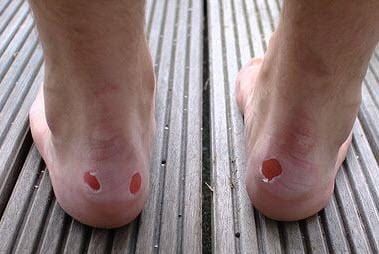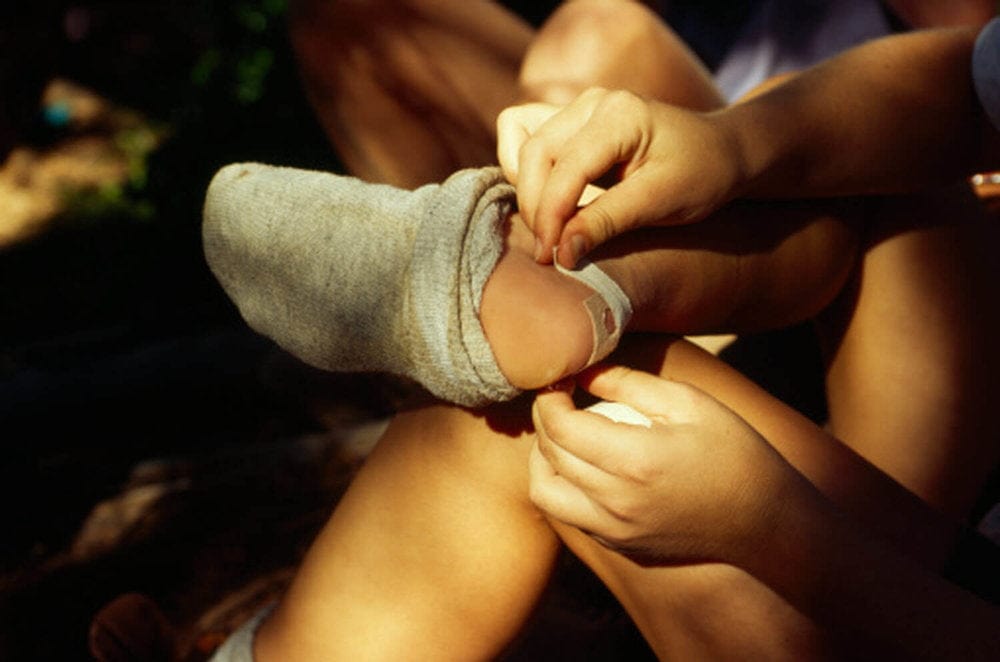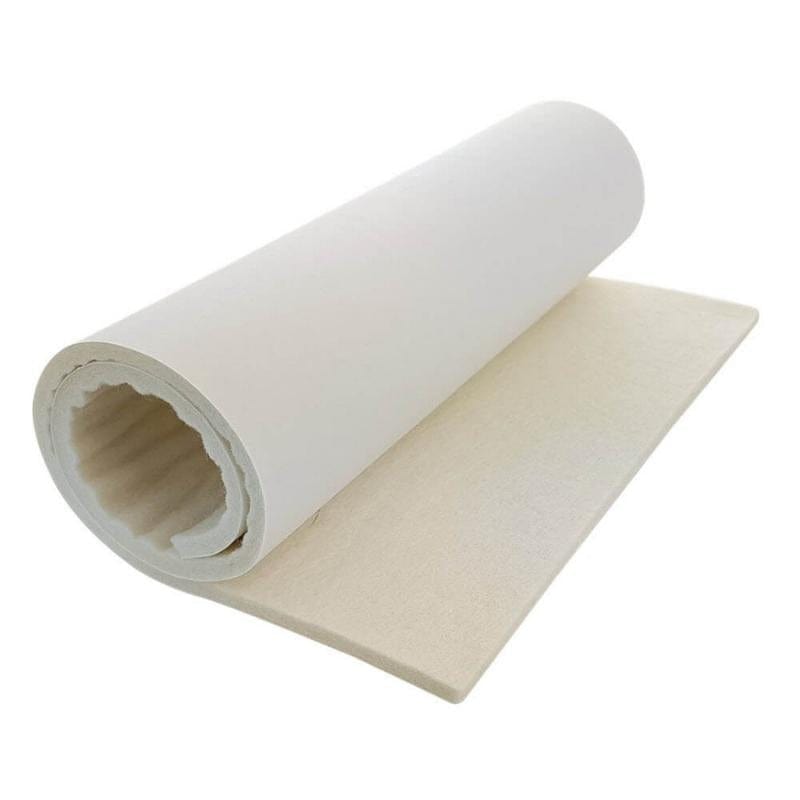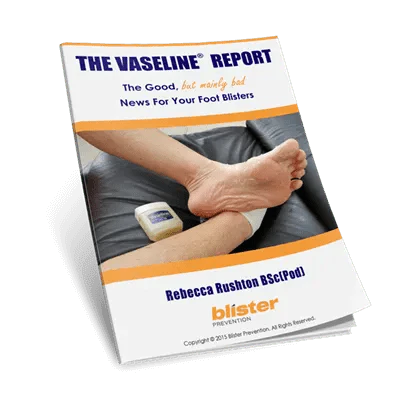UPDATED: Blisters at the back of the heel are the most common type of heel blister, by far. In fact, they're my most common blister and the reason my quest to understand everything about blisters started. While there are two other types of heel blisters, namely blisters under the heel and heel edge blisters, in this article, we'll concentrate on back-of-heel blisters exclusively. I'm going to explain why they occur; plus the pros and cons of all the treatments people use to relieve and prevent these blisters.
Back-of Heel Blisters More Common in Walking Than Running
Blisters behind the heel bone are more common in walking and hiking compared to running. They can be just plain debilitating, as many of us know. This email from Marcus (several years ago now) describes the struggle perfectly after I helped him find the perfect solution:
We completed the Overland Track around 10 days ago and I have been meaning to report back to you. In 30 years of bushwalking in Tasmania I have never completed a walk of any distance without some kind of heel blister - on this trip I survived 6 days and 70 kilometres of walking carrying a 25 kilo pack without ANY blister of ANY kind... The upshot of all of this is that I was able to enjoy the walk and that my wife and children were along for the trip with me. Under normal circumstances I would have been in quite serious discomfort after day three and basically become totally self-absorbed for the last 3 days enduring the pain.

Deroofed heel blisters
Heel Anatomy and Biomechanics
The heel bone (calcaneus) is pulled upwards by tension in the Achilles tendon when we walk, specifically, at heel lift. Then it moves down again at heel strike and compresses into any cushioned aspects of your shoe. This biomechanical function is normal and necessary. However, sometimes it can happen to excess. If the calf muscles are tight, extra tension in the tendon causes the calcaneus to lift sooner, higher and with more force.
On top of that, there's a little bony lump just a little to the outerside of the back of the heel. This is completely normal but it's why the majoity of back-of-heel blisters are a little to the outside. This normal bony lump can also become larger and develop into what's known as Haglund's deformity or pump-bump and predisopse to blisters even further.
Heel Blister Research
In 2013, a team at the University of Salford produced blisters on the back of the heels of 30 people under very controlled conditions to measure temperature changes in the skin. Putting the temperature changes to the side - if you’ve ever wondered why you get heel blisters easily while your friends don’t, these results give you an idea why. One participant blistered after 4 minutes while the last one to blister took 32 minutes! This gives great insight into how some of us blister much easier than others.
The same researchers also mentioned something interesting about the amount of heel movement in the shoe. A pilot study, previous to the 2013 research, used slow motion high speed video analysis to determine that there was a 15mm displacement of the heel relative to the back of a shoe at heel strike. That's a lot! So, the heel moves downwards relative to the back of the shoe by around 15mm with each heel strike. And then moves up again during the remainder of the gait cycle, so it can move down again at the next heel strike.
The 6 Most Common Back-of-Heel Blister Prevention Strategies (And How They Work)
While these are the most popular preventions, make no mistake, you can and should use some kind of prevention when you're treating a back-of-heel blister. So, let's look into the pros and cons of each one so you can choose the one that's best for you.
1) Heel-Lock Lacing Technique
HOW IT WORKS: Stops your heel bone from moving up and down so much.
PROS: Easy to do.
CONS: If you have shoes with laces.
MY EXPERIENCE: This helps, so try it. However, it didn’t always stop me from getting back-of heel blisters.
PS: Here's how to do it with hiking boots.
2) Taping
HOW IT WORKS: Spreads shear load and reduces rubbing
PROS: Tape is easy to come by. I've used Fixomull Stretch in this video but you can use any tape like paper tape, RockTape, Leukoplast or moleskin (moleskin is just a thick tape, in my book).
CONS: You have to reapply it every day.
MY EXPERIENCE: A lot of people find taping ia all they need to stop heel blisters. I wished I was that lucky. While I found it saved me from the red raw deroofed blisters on the back of my heels (a big relief!), it didn’t always stop me from getting blisters.
PS: If you get back-of-heel blisters in spite of taping, here’s why. Don't be disheartened, just move on to one of the other options.
3) Donut Pads
HOW IT WORKS: Reduces pressure.
PROS: Easy enough to implement. Learn how to make your own donut pads here.
CONS: The thicker the better for pressure relief, but takes up a lot of room in your shoe.
MY EXPERIENCE: While a donut pad makes intuitive sense, and they can help blisters in lots of areas of your foot, I never found it gave enough relief to my poor back-of-heel blisters once they were blistered.
PS: Rather than moleskin, use podiatry felt which is much thicker, and Fixomull Stretch over the top. I've popped a video below so you can see how to make a donut pad from felt (albeit for the ball of the foot in the video).

This moleskin donut pad is quite thin - a thicker podiatry felt donut pad would offer more protection. I use the 5mm felt in our online store.
4) Calf Stretches
HOW IT WORKS: Reduces bone movement
PROS: Often overlooked so this could be the missing link for you
CONS: Takes 8 weeks of daily stretching to make a substantial difference.
MY EXPERIENCE: I'm not tight in my calves so this wouldn't have helped.
PS: Technique is everything with this stretch, so watch the video below to avoid the common errors.
5) Engo Blister Patches
HOW IT WORKS: Reduces friction levels.
PROS: Once in place on your shoe, it stays there for weeks/months/years. They're very thin so they don't change the fit of your shoe.
CONS: Make sure you protect the top of the patch as you slide your heel into your shoe. And don't put your shoes in the washing machine - the soapy water will make it come off the shoe.
MY EXPERIENCE: ENGO Blister Patches are the best form of heel protection I’ve found for even the worst back-of-heel blisters. In other words, if you just did one thing, this would be the one to do.
PS: It may sound counter-intuitive, ENGO Blister Patches encourage a little rubbing at the back of your heel. But it’s a LOW FRICTION RUB instead of a HIGH FRICTION RUB and that makes all the difference to saving your skin. This way, your sock protects your skin rather than rubs against it.
PPS: Like Marcus (at the top of this article), I think they’re heel blister prevention gold! You get two patches in each ENGO Heel Pack. They’re shaped like a heel grip. Watch the video below to see how to apply them.
PPPS: You know how I said my blister quest started because I had troublesome heel blisters? Well, my quest started in ernest when I discovered these patches work so well compared to everything else I've ever tried and I just had to find out why.
6) PelliTec Blister Pads
HOW IT WORKS: Does a little bit of a lot of things - reduces pressure, absorbs a bit of shear, maybe reduces friction levels.
PROS: The pads apply to your shoe and are detachable and re-stickable.
CONS: The edges can be noticeable. While they work in several ways, they don't excel at any one mechanism. While the pad is 4.5cm in diameter, the area of blister protection is 2.5cm.
MY EXPERIENCE: These irritated more than they relieved. But, as you'll read here, some people loved PelliTec Blister Pads.
PS: Watch the video for all my thoughts.
What's Our Pick For Back-of-Heel Blisters?
The most effective preventative strategy for even the worst heel blisters is the ENGO Blister Patches, even if you have a Haglunds deformity. They’re the things that keep me blister-free day in day out, without having to pad or tape my skin all the time. The other strategies will help for sure, but the ENGO patches are the best, in my humble opinion.
Get Started With ENGO Heel Patches
To learn more about ENGO Heel Blister Patches, including where to buy, hclick "view product" below.
References
Hashmi, F, Richards, BS, Forghany, S, Hatton, AL and Nester, CJ. 2013. The Formation of Friction Blisters on the Foot: The Development of a Laboratory-Based Blister Creation Model. Skin Research and Technology. 19: e479-e489.








